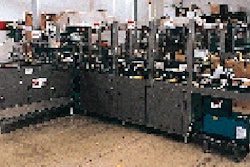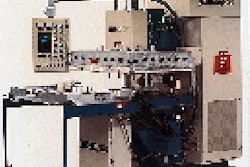
Conveyors and marking machines are the traditional mechanical components for packaging lines. But somewhat less understood is the burgeoning field of electronic controls. In Part Two of our exclusive survey on components, we focus on electronics components and on machine logic and software-and the plant people who need to be conversant with them.
Last month, our report on the survey (see Packaging World, Oct. '96, p. 76) covered the broad range of components and described which types of components packaging engineers specified and which types they knew most and least about.
In Part One engineers and other production executives from small to medium to large companies reported that mechanical components like conveyors and coding and marking machines were most familiar. Meanwhile, control language and PLSs (programmable limit switches) were least familiar. Machine vision systems, personal computers, programmable logic controllers, and sensors were also less familiar to many survey respondents.
In a few years, this ranking is likely undergo a major change. But in 1996, electronic controls are among the areas in packaging least familiar to many engineers and operations personnel. Thus, they rely heavily on vendors. The obvious conclusion is that many packaging people are in the midst of the shift from mechanical to electronic controls. While their experience makes them more comfortable with mechanicals and pneumatics, most recognize that they're beginning to climb the learning curve when it comes to electronics.
This Packaging World survey of readers was conducted with the help of Market Research Support Services (Itasca, IL), an independent research consultancy. It employed a comprehensive mail survey form and used the input of well over a hundred responses that closely matched the profile of our readers with about 50% in the food industry, 25% in the medical, pharmaceutical or chemical business and the balance from a wide variety of manufacturing businesses that includes industrial packaging.
Who needs to know?
Just how pervasive is electronically-controlled equipment in packaging? And which plant workers need to understand controls most? To find answers to these questions, the exclusive PW survey asked participants how important understanding electronic controls is to three types of packaging workers in the plant (Charts 1A, 1B, 1C).
For packaging mechanics, it's absolutely vital to understand electronic controls, our survey respondents declared emphatically. This knowledge is very important to the mechanic, said 92.3% of respondents. This validates the skills that were identified for the packaging mechanic in PW's Packaging 2000 series of job profiles (see PW, Oct. '96, p. 53). Another 6.2% of survey participants said this knowledge was relatively important, and only 1.5% felt these skills were unimportant.
Understanding electronic controls is very important to packaging engineers too, respondents say. Some 75% rate this knowledge as very important, while another 16.4% say it's relatively important for packaging engineers. Just 8.6% of the participants thought understanding electronics was unimportant for packaging engineers.
The survey also asked about electronic controls and the packaging machine operator. A big majority of survey respondents say that knowledge of electronic controls is relatively or very important to machine operators. Almost one-third of the respondents (32.6%) said this skill was very important, and another 43.2% rated it as relatively important.
One in four respondents (24.2%) claimed understanding of electronics was unimportant for machine operators. Although this ranking for machine operators surprised PW editors a bit, it reinforces the views of the "visionaries" who helped identify the skills of the packaging machine operator in the Packaging 2000 series of job profiles (see PW, Oct. '96, p. 53).
Heavy computer use
As the survey began to focus on electronic and computer controls, respondents were asked first whether their plant used packaging that was controlled by computer programming (Chart 2). Of all respondents, 69.4% answered "yes," while slightly more than 30% said "no."
While one would expect a close correlation between respondents who report using computer-controlled equipment and those who specified programmable components (PCs, PLCs or PLSs), the match wasn't uniform. For example, nearly 17% of the participants who say they specify control language for their plant report no packaging equipment with computerized control.
It seems likely that this dichotomy may be caused by two factors. At least some of our readers also have responsibilities on the processing side of the business. So they may be purchasing computer components to regulate product-related operations that occur ahead of packaging. Or the PCs and other computers are used in engineering departments or even in warehousing and distribution.
The other factor is the delineation between PC-controlled equipment and machines that may be a step or two away from that. Obviously, many machines employ independent control language for smooth operation, yet the control system does not require a full computer.
Another oddity: 12% of survey respondents who say they're involved in purchasing machine vision systems claim their plants don't have computer-controlled packaging machinery. Perhaps these participants are separating quality control instruments from packaging machinery.
In-plant programming
Many conclusions of the survey point to early adoption of electronics and computers in packaging, but some suggest that manufacturers have a substantial amount of experience in using and customizing electronic and computer controls.
At least that's the conclusion we draw from the responses to the question, "Who writes software programming for packaging machinery?" (Chart 3). Multiple responses were allowed so the answers total more than 100%.
While we expected that a relatively small number of packaging engineers would be involved in software writing (7.8%), we were somewhat surprised that "company engineers" led the way at over 42%. This may reflect the influence of larger companies that have engineering support staffs that are in addition to the plant engineers.
Company engineers were closely followed by the packaging machinery OEMs at 41.1%. System integrators made a strong showing in software writing at 25.6%, and other consultants were used in about one of five companies.
Of those respondents who buy PCs, PLCs or PLSs, the machinery makers scored even higher. Nearly half of these say they use software from the packaging machinery manufacturers.
Who does troubleshooting?
Next, the survey asked which job titles were responsible for fixing problems that can arise in packaging machine logic or programming (Chart 4). Once again, the maintenance mechanic was most prominent. Nearly half of all answers (49.5%) named the maintenance department or packaging mechanic as responsible for solving problems in logic or software. Not far behind were company engineers, at 45.2%.
Packaging engineers (7.5%) and machine operators (6.5%) were at the other end of the scale.
The other three troubleshooters are probably the strongest indication in this survey of the affects of outsourcing in packaging. More than 18% of the answers named the machine builder as the one responsible for fixing programming. Consultants were named nearly 12% of the time, and system integrators were pegged to solve the problem almost 10% of the time. Naturally, many of the survey participants had more than one answer.
This reliance on others outside the company was also evident when the survey asked about the responsibility for training workers on sophisticated electronics.
Looking for support
Keeping in mind that respondents represented a broad cross-section of companies, from very small to very large, it isn't unexpected that many of these engineers say their firms rely on vendors to provide the bulk of training people in sophisticated electronic controls (Chart 5). Here again, we permitted multiple responses since it's rare when all training is the province of one job or company.
The chart shows how often each answer was given. Another way to look at the responses is to note that of all responses, machinery manufacturers were cited 25.1% of the time, and component makers made up 24% of the responses. Consulting trainers (10.1%) and system integrators (8.9%) were the other two "vendors" who had training responsibilities for electronics. Thus, of all answers on the topic of training responsibility, nearly seven in 10 said the responsibility was borne by equipment manufacturers or consultants.
Of the balance of responses, 18.4% said that plant management assumed the training responsibility, and company trainers received 13.4% of the responses.
This dependence on manufacturers and other outside suppliers is strongly supported by the responses when the survey asked about the importance of equipment manufacturer recommendations in purchasing components. Given a scale of 1 to 5 (from least to most important), 11.1% said the machinery maker's recommendations were most important in component choice.
Actually, more than half of all respondents rated the machinery maker's suggestion as very important, a four on the scale. Another 29% were ambivalent, rating it a three on the scale. At the other end of the scale, just 1.5% rated the recommendation as totally irrelevant.
Finally, we asked respondents to list their sources of information about components (Chart 6). As the numbers show, component manufacturers rank the highest, corporate recommendations ranked the lowest. Publications like Packaging World were also rated highly as sources of information about components.























